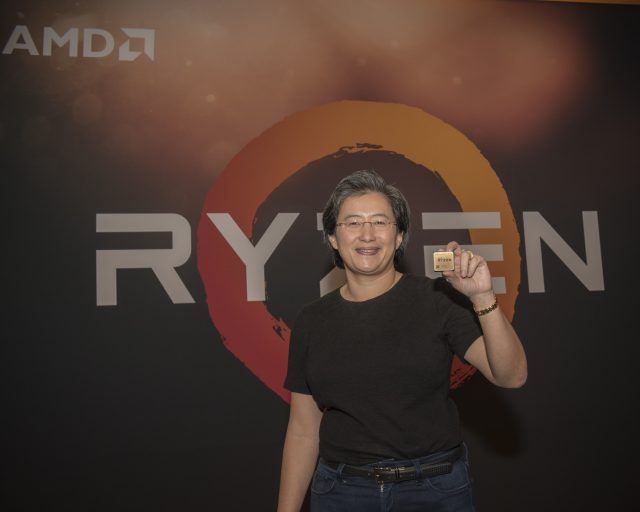
SAN FRANCISCO—Oasis' smash hit "Wonderwall" was playing as the throng of journalists assembled in the ballroom of a Grand Hyatt hotel in San Francisco at AMD's Ryzen Tech Day. I don't know why the song was picked—normally these events prefer something a little more current and upbeat—but it sure seemed apt. As CEO Lisa Su and others were preparing to speak, one of the Gallagher brothers (who knows which one) drearily droned the question, "You're gonna be the one that saves me?"
AMD is a company that needs saving. Although there have been occasional high spots, such as the design wins for both the PlayStation 4 and the Xbox One, the last few years have been heavy going for the chip designer. Its main products—desktop and server processors—haven't been very good at all, forcing it to sell only to the very lowest of the low-end customers. Intel has handily dominated the performance-oriented desktop processor market for the last decade, after AMD's Bulldozer family brought widespread disappointment.
But in 2015, Su made clear that the company needed high-performance, high-end parts, and those parts are very nearly here.
On March 2, and preorderable today, the first three Ryzen processors will be available to buy. All three processors use AMD's brand-new Zen core. All are eight-core, 16-thread parts; all have a 16MB level 3 cache shared across all cores; and all three are unlocked for overclocking.
The top-end part is the R7 1800X. This $499 chip will have a 3.6GHz base speed and a 4.0GHz boost speed, with a 95W TDP. AMD is positioning it against Intel's i7-6900K, a $1,050 processor using the Broadwell-E core running at 3.2 GHz, and turboing up to 3.7GHz.
In the Cinebench R15 multithreaded rendering test, AMD says that its new processor scores about 9 percent higher than Intel's. In the single threaded version of the same test, it's a dead heat.
AMD hasn't quite matched Broadwell's instructions per clock—it's relying on a few hundred extra megahertz to achieve that tied score—but it's not far off. And given that the Ryzen ships at a few hundred extra megahertz more than Intel's twice-as-expensive chip, the shortfall in IPC is largely academic. IPC is interesting in that it gives a sense of how cores are designed, but workloads aren't constrained by IPC or clock speed per se; they're constrained by thermal and power constraints. And AMD compares very favorably there, too: the Intel chip is a 140W part, so can use about 50 percent more power than the AMD.
Per AMD's demonstrations, the Ryzen also beat the Intel chip in Handbrake video encoding and boasted somewhat better frame rates in Sniper Elite 4 at 4K.

The other two parts are the R7 1700X, a $399 part with a base of 3.4GHz and a boost of 3.8GHz; and the R7 1700, with clocks of 3.0 and 3.7GHz, selling for $329. AMD is positioning these against the $439 Intel Core i7-6800K (a six-core, 12-thread part) and $349 Core i7-7700K, respectively.
This last comparison is particularly significant; the Kaby Lake processor is only a four-core, eight-thread processor. It has a sizable clockspeed advantage—its base frequency of 4.2GHz is higher than the boost frequency of any Ryzen, and it turbos all the way up to 4.5GHz—and AMD concedes that in strictly single threaded workloads, the Intel chip will open up a gap over the Ryzen, but as soon as you're doing something that can use all eight of those cores and all 16 of those simultaneous threads, that clock speed delta shows its limits: in Cinebench the Ryzen is 46 percent faster.
The company was aiming to improve IPC by 40 percent over its previous processor design, and Lisa Su said that it didn't just hit this target—it surpassed it for a 52 percent improvement. This puts AMD back in the performance game.
Full benchmarking will have to wait—the reviews will not arrive until launch day—but if the Cinebench scores are indicative, Ryzen isn't just giving AMD its first credible desktop processor for more than a decade; it's also putting Intel on the back foot, leaving Intel's already expensive Broadwell-E chips looking very overpriced indeed.
AMD is promising that March 2 will be a hard launch, too, with chips in abundant supply, 82 or more different motherboards from a wide range of OEMs, and systems from 19 different boutique PC vendors. All the major OEMs should have Ryzen systems within about 30 days of launch, too.
Late in the year, the company will be launching its new Vega GPU architecture, the Zen-based Naples server CPU, mobile Ryzen parts with integrated graphics processors, and Radeon Instinct headless GPUs designed for supercomputing number crunching.
All told, 2017 is going to be a big year for AMD. If Ryzen truly delivers on its promise, and early indications are that it does, it should prove transformational for the company, giving it—and perhaps even parts of the PC market itself—the wonderwall it so desperately needs.
reader comments
267